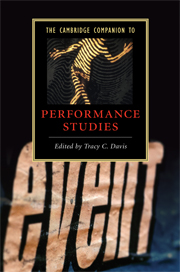Book contents
- Frontmatter
- Introduction: the pirouette, detour, revolution, deflection, deviation, tack, and yaw of the performative turn
- Part I Social polities: history in individuals
- Part II Body politics: the individual in history
- 7 Live and technologically mediated performance
- 8 Moving histories: performance and oral history
- 9 What is the “social” in social practice?: comparing experiments in performance
- 10 Live art in art history: a paradox?
- 11 Queer theory
- Further reading
- Index
10 - Live art in art history: a paradox?
from Part II - Body politics: the individual in history
Published online by Cambridge University Press: 28 January 2009
- Frontmatter
- Introduction: the pirouette, detour, revolution, deflection, deviation, tack, and yaw of the performative turn
- Part I Social polities: history in individuals
- Part II Body politics: the individual in history
- 7 Live and technologically mediated performance
- 8 Moving histories: performance and oral history
- 9 What is the “social” in social practice?: comparing experiments in performance
- 10 Live art in art history: a paradox?
- 11 Queer theory
- Further reading
- Index
Summary
Until the 1990s, the discipline of art history, as developed in Europe and North America from the nineteenth century onward, refused to acknowledge the crucial role of the body in the production and reception of works of art. Art history and its discursive and institutional corollaries, the art gallery, the auction house, and much of art criticism, thus systematically ignored the body, even (after 1960) in the face of the development of an explosive interest in representing, enacting, or otherwise foregrounding the body as central to the experience of visual culture. This chapter addresses why this was the case and explores how shifting emphases on the body in the production and reception of visual arts practices in the post-Second World War period insistently wore away at the occlusion of the body in art discourses and institutions. It will then examine the fact that, in the 1990s, a new generation of art historians and critics had began to theorize the central importance of the body as a crucial matrix, ground, and activating source for meaning and value in the visual arts and visual culture in general. The suppression or erasure of the live or inhabited body in institutionalized versions of art discourse and in art institutions has a long history in Euro-American culture.
- Type
- Chapter
- Information
- The Cambridge Companion to Performance Studies , pp. 151 - 165Publisher: Cambridge University PressPrint publication year: 2008
- 5
- Cited by

